Medici Prince's Chapel | Michelangelo Sacristy | Location | Opening Hours Tickets | Authorizations
Pictures Chapel | Dome Frescoes | Reliquaries
The Medici Chapel, the Chapel of the Princes in Florence
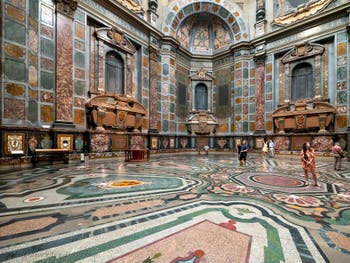
The Chapel of the Princes The chapel mausoleum of the Medici is called the princes' chapel. It is adjacent to the Sagrestia Nuova, the New Sacristy, the Michelangelo Chapel.
The Medici Chapel of the Princes is on the upper floor, majestic by the size, decoration, and materials.
This chapel of the Princes was a plan of Cosimo I de Medici as a self-celebration of the Medici.
The Medici family had high self-esteem!
At the end of 1568, Cosimo I of Medici ordered the Prince's chapel's construction which ended in 1644. But its construction has truly begun under Duke Ferdinand I de Medici.
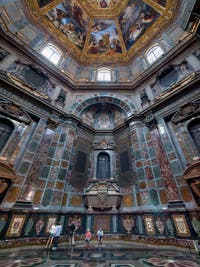
The Chapel of the Princes In 1602, after a competition among the projects presented by Buontalenti, dal Silvani and Matteo Nigeti, it was the latter who was designated to create the Chapel of the Princes.
Matteo Nigetti was responsible for the construction site until 1650.
Work that lasted for the whole century, but in a relatively slow way, as the family's finances were no longer what they used to be.
Anna Maria Luisa de Medici, the last descendant of the dynasty, gave the impulse to finish the building still to see the laying on of the dome during her lifetime.
Le Pietre Dure, the Hard Stones
The interior is a riot of marbles of all kinds, granite and semi-precious stones from worldwide.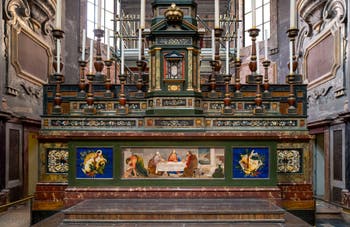
Altar of the Chapel of Princes To succeed in making, finding, working all the stones intended to be inlaid, was created in 1588 the manufacture Delle Pietre Dure.
This factory still exists today; it has become a national institution specializing in catering and a museum that you can visit.
The Prince's chapel's floor work, a superb mosaic of marbles and hard stones, began in 1874 and did not end until 1962.
The Chapel of the Princes is towered by a large dome, placed on an octagonal body of .
Its height is 58 metres.
The Sarcophagus of the Grand Dukes
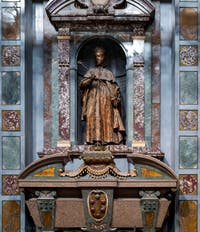
Ferdinando I de Medici The coffins of the chapel, from Cosimo I to Cosimo III, are made up of large arches of porphyry and grey granite.
On each of the caskets is laid the crown of the grand dukes.
Each arch should accommodate a statue of the corresponding duke.
Still, two were made, Ferdinand I, in gilded bronze, a work by Pietro Tacca (1626-1632) and Cosimo II, partially gilded, by Pietro and Ferdinando Tacca (1626-1642).
The statues of the two grand dukes wear the garb of Grand Master of the Order of the Knights of St Stephen, San Stefano.
The Coat of Arm of Tuscany Cities
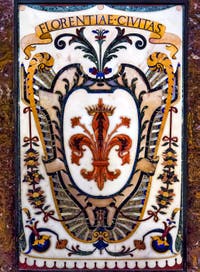
Florence Coat of Arms All along the walls are represented the coats of arms of Tuscan cities in marquetry where quartz, mother-of-pearl, alabaster, lapis lazuli jasper, coral and other semi-precious stones are mixed.
The sarcophagi of the Grand Dukes are up to the task, overwhelming, imposing!
The laying of marbles and hard stones on the ground began in 1874, and the hard stone factory did not finish this superb work until 1962.
Chapel of Prince Pictures
The frescoes in the dome of the Medici Prince's Chapel
Initially, one planned to coat the inner walls of the dome with ultramarine lapis lazuli, decorated with gilt bronze flowers.But the Medici dynasty's extinction did not allow carrying out the original project, and frescoes, therefore, covered the dome.
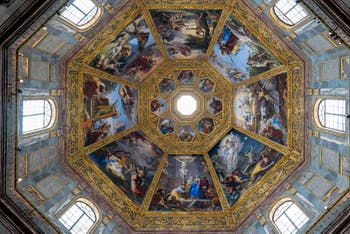
Dome's Frescoes Chapel of Princes Abbot G.B. Zannoni conceived the project of the paintings of the dome.
Hexagons meet at the dome's top, each of which presents the faces of the four prophets and the four evangelists.
The Dome's Frescoes Cycle
These frescoes, representing scenes from the Old and New Testaments, are by Pietro Benvenuti and were made between 1828 and 1837.The frescoes represent the history of Genesis: The creation, the original sin and the death of Abel.
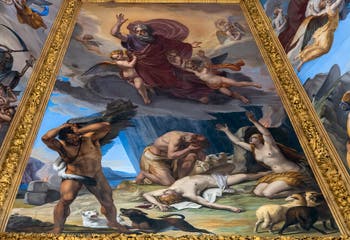
Dome's Frescoes Chapel of Princes Then come the scenes of Jesus's life: the nativity, the crucifixion and the resurrection.
The cycle of frescoes ends with Universal Judgment.
Dome's Frescoes Pictures
The Treasure of San Lorenzo in Florence
The two small side rooms of the Chapel of the Princes, as the crypt under the church, display about a hundred reliquaries belonging to the Treasury of San Lorenzo.The Two treasure rooms are accessible through small corridors located on either side of the altar.
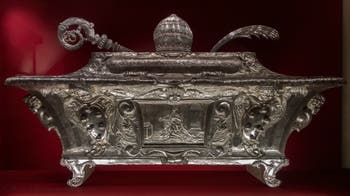
Reliquary of Pope St. Mark Several of these reliquaries, including a rock crystal vase, belonged to Lorenzo the Magnificent.
A reliquary is a casket containing a saint's fragment.
One can also admire a silver crozier of the sixteenth century, offered by Pope Leo X, son of Lorenzo the Magnificent Medici.
A beautiful mitre is also on display; Pope Clement VII (Son of Giuliano de Medici, brother of Lorenzo the Magnificent) offered it, son of Giuliano de Medici, the brother of Lorenzo the Magnificent.
Reliquaries and Processional Banner of Pope Leo X
Many reliquaries are on display here.The reliquary of Saint John the Charitable, Saint-Pascal Baylon, Saint Roch, Saint Thomas of Hereford, Saint Blaise, Saint Paul Hermit, Saint Conrad, Saint Emeric, Saint Ambrose, Saint Theodosius; without forgetting, as it should be in the Medici family, the reliquary of Saint Cosmas.
Finally, you can see a beautifully embroidered processional banner of Pope Leo X.
Reliquaries and San Lorenzo Pictures
Michelangelo New Sacristy
Pictures Chapel | Dome Frescoes | Reliquaries
Medici Prince's Chapel | Michelangelo Sacristy | Location | Opening Hours Tickets | Authorizations
Back to Top of Page

